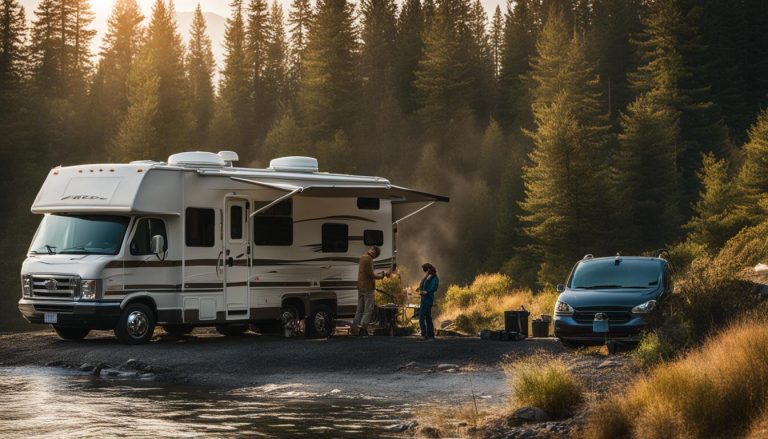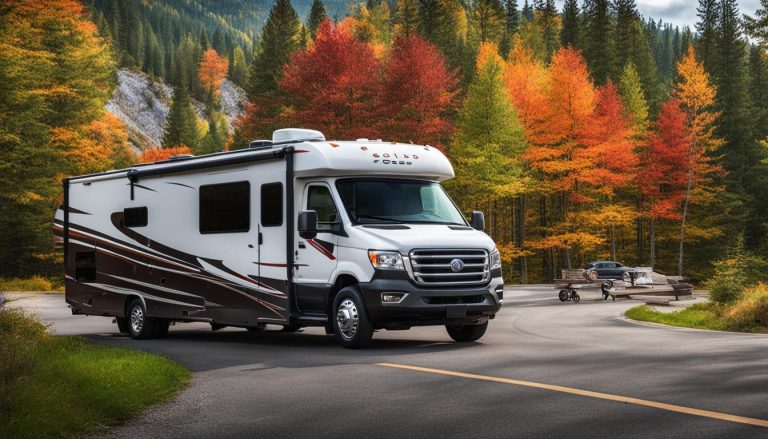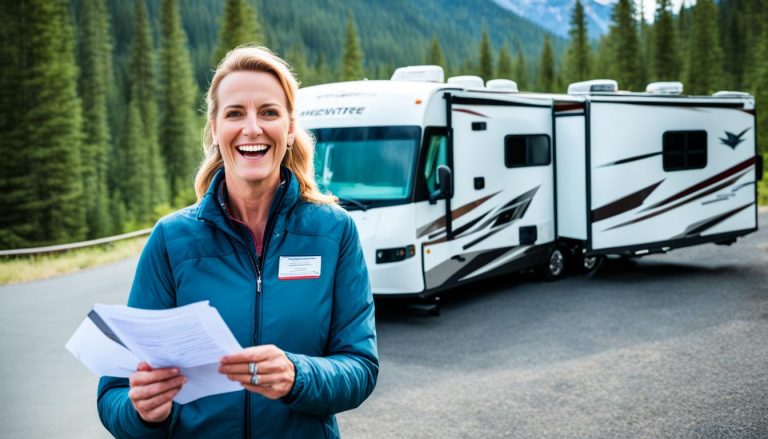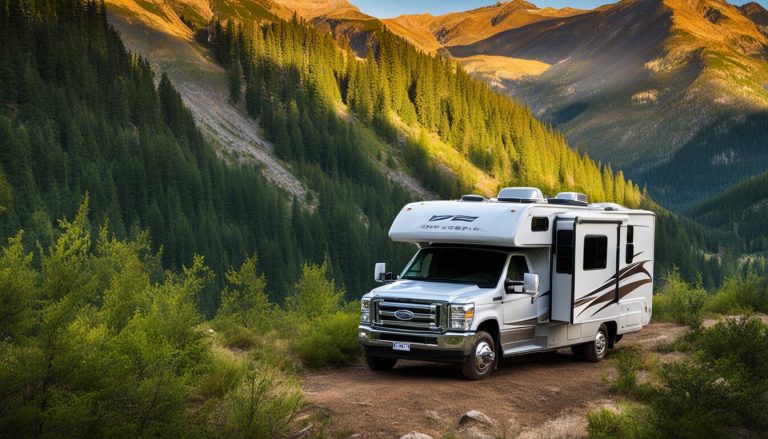Weigh Your RV at CAT Scale: Step-by-Step Guide
gorvlifestyle.com and its partners may earn a commission if you purchase a product through one of our links
Welcome to our step-by-step guide on how to weigh your RV at a CAT Scale. Ensuring that you have accurate weight measurements for your RV is crucial for safe and enjoyable travels. Overloading your RV can lead to safety hazards and potential damage to your vehicle, so it’s essential to know the weight distribution and stay within the manufacturer’s limits.
In this guide, we’ll walk you through the process of weighing your RV at a CAT Scale and provide you with valuable tips on managing your RV weight effectively. With this knowledge, you’ll have the confidence to hit the road knowing that your RV is properly loaded and within its weight limits.
Key Takeaways:
- Weighing your RV at a CAT Scale ensures safe travels and prevents overloading.
- Knowing your RV’s weight and weight distribution is important for stability and performance.
- RV weight ratings provide maximum weight limits for safe operation.
- Using a CAT Scale or the four-corner weigh method can provide accurate weight measurements.
- Accurate weight data helps with tire inflation, weight distribution, and overall RV weight management.
Why Is Weight Important For Recreational Vehicle Owners?
Understanding the importance of weight management for your RV is critical for safe and efficient travels. Exceeding your RV’s weight limits can strain the vehicle’s components, leading to potential damage and safety risks. By properly managing your RV’s weight and ensuring proper weight distribution, you can enhance stability, prevent tire blowouts, and maintain optimal performance during your journeys.
Proper weight management is vital because an overweight RV puts unnecessary stress on various parts, such as the engine, brakes, suspension, and tires. This additional strain can lead to premature wear and tear, increasing the risk of mechanical failures and accidents. It is essential to remember that RVs have specific weight ratings determined by the manufacturer. These ratings indicate the maximum weight that your RV can safely carry without compromising its structural integrity and overall performance.
Quote:
By managing the weight of your RV, you can ensure a smoother and safer traveling experience. The right weight distribution helps keep your RV stable, especially during turns and sudden maneuvers. It also reduces the chances of tire blowouts, which can be dangerous on the road. Take the time to understand the weight limits and recommendations provided by your RV manufacturer to avoid potential risks.
Weight distribution is another essential consideration for RV owners. Improper weight distribution can lead to imbalanced load distribution, causing uneven tire wear, compromised handling, and even instability on the road. To maintain proper weight distribution, you must distribute the weight evenly across the axles of your RV. This ensures that each tire is properly supporting its share of the load, maximizing grip and stability.
To visualize the importance of weight distribution, consider a dining table with one leg shorter than the others. The table becomes wobbly and unstable, making it impractical for use. Similarly, an RV with uneven weight distribution can experience similar issues, compromising your safety and comfort while on the road. Ensuring proper weight distribution minimizes these risks and enhances the overall driving experience in your RV.
RV Weight Management Tips
Here are some essential tips for effectively managing the weight of your RV:
- Regularly weigh your RV using certified scales like CAT Scales to ensure you stay within the manufacturer’s weight ratings.
- Consider the weight of all passengers, equipment, and supplies that will be carried during your trips.
- Distribute the weight evenly across the axles of your RV, ensuring proper weight distribution.
- Pay attention to cargo placement and avoid overloading any particular area.
- Check tire pressures regularly and inflate them according to the manufacturer’s recommended levels based on the RV’s weight.
Following these weight management tips will help ensure that your RV operates optimally, enhances your safety on the road, and preserves the longevity of your vehicle’s components.
| Benefits of Weight Management | Risks of Overloading |
|---|---|
| Enhanced stability | Potential damage to vehicle components |
| Improved tire life and reduced blowout risks | Compromised handling and control |
| Optimal performance | Increased risk of mechanical failures |
| Reduced fuel consumption | Uneven tire wear |
How Do I Find My RV’s Weight Rating?
Before weighing your RV, it is essential to know its weight rating. RV manufacturers usually provide weight ratings in the specifications list of their models. These ratings include specifications such as Unloaded Vehicle Weight (UVW), Cargo Carrying Capacity (CCC), Gross Vehicle Weight Rating (GVWR), and Gross Axle Weight Ratings (GAWR). These weight ratings will help you understand the maximum weight your RV can safely carry and distribute the weight properly.
Knowing your RV’s weight rating is crucial for proper weight management and ensuring a safe travel experience. When you exceed your RV’s weight limits, you risk overloading the vehicle, compromising its stability, and potentially damaging its components. By adhering to the weight ratings, you can maintain optimal performance and safety on the road.
Understanding the RV Weight Ratings:
| Weight Rating | Description |
|---|---|
| Unloaded Vehicle Weight (UVW) | The weight of the RV as it comes from the factory, including full fuel, fluids, and standard equipment. It does not include any personal belongings, passengers, or aftermarket modifications. |
| Cargo Carrying Capacity (CCC) | The maximum weight of personal belongings and additional cargo that can be safely carried in the RV. It is the difference between the GVWR and the UVW. |
| Gross Vehicle Weight Rating (GVWR) | The maximum weight limit that an RV can safely carry, including its own weight, passengers, cargo, and any towing or hitch weight. |
| Gross Axle Weight Ratings (GAWR) | The maximum weight that each axle can safely carry. It ensures that the weight is evenly distributed among the axles and prevents overloading. |
Understanding these weight ratings is essential for determining the maximum weight your RV can handle and distributing the weight properly among its components. This knowledge enables you to make informed decisions about loading your RV, optimizing weight distribution, and ensuring safe travels.
Having a clear understanding of your RV’s weight rating is the first step towards proper weight management. With this knowledge, you can confidently embark on your adventures, knowing that you are keeping your RV within its safe weight limits.
RV Weighing Option 1: Certified CAT Scale
One of the best options for weighing your RV is to use a certified CAT Scale. CAT scales, also known as truck scales, can be found at most truck stops and are easy to use. Simply take your RV to a CAT Scale, position it on the platform scales with the assistance of a spotter, and get each axle weighed separately. This method provides accurate weight measurements and is widely accessible for RV owners.

Utilizing a certified CAT Scale offers several advantages. It enables you to obtain precise weight measurements for your RV, ensuring you stay within safe weight limits. The CAT Scale’s platform scales can accommodate your entire RV and provide separate axle weights, allowing you to assess weight distribution accurately. By weighing each axle individually, you can identify any imbalances and make necessary adjustments for enhanced safety and performance.
When using a CAT Scale, it’s essential to position your RV correctly on the platform scales. A spotter can guide you to ensure accurate placement and prevent any measurement errors. Taking the time to properly weigh your RV at a certified CAT Scale will give you peace of mind and help you maintain a safe and enjoyable travel experience.
RV Weighing Option 2: Four Corner Weigh
If you’re looking for a more in-depth analysis of your RV’s weight distribution, the four-corner weigh method is an excellent option to consider. This method provides comprehensive information about the weight placed on each wheel position, allowing you to optimize weight distribution and enhance overall stability.
The four-corner weigh method typically requires an appointment and may be more expensive compared to using a CAT Scale. However, the detailed weight data obtained from this method offers valuable insights into how weight is distributed across your RV.
With four-corner weighing, you can identify any imbalances in weight distribution and make necessary adjustments, such as redistributing cargo or adjusting tire pressures, to ensure optimal handling and safety on the road.
How Four Corner Weigh Works
- First, locate a certified RV weighing station that offers four-corner weigh services.
- Make an appointment and arrive at the weighing station with your RV fully loaded as it would be for travel.
- The weighing technician will position your RV’s wheels on individual scales, allowing for precise measurement of the weight on each wheel.
- Once the weighing is complete, the technician will provide you with the weight measurements for each wheel position.
- Use the collected data to assess the weight distribution and make necessary adjustments to ensure balanced weight placement.
| Wheel Position | Weight (lbs) |
|---|---|
| Front left | 3,500 |
| Front right | 3,550 |
| Rear left | 3,400 |
| Rear right | 3,520 |
By knowing the weight placed on each wheel, you can optimize weight distribution by adjusting cargo placement, redistributing weight, or addressing any potential imbalances. This allows for better control, improved braking performance, and reduced wear and tear on your RV’s components.
Note: It’s essential to consult your RV’s manufacturer guidelines and specifications to ensure you’re within safe weight limits and distribution parameters.
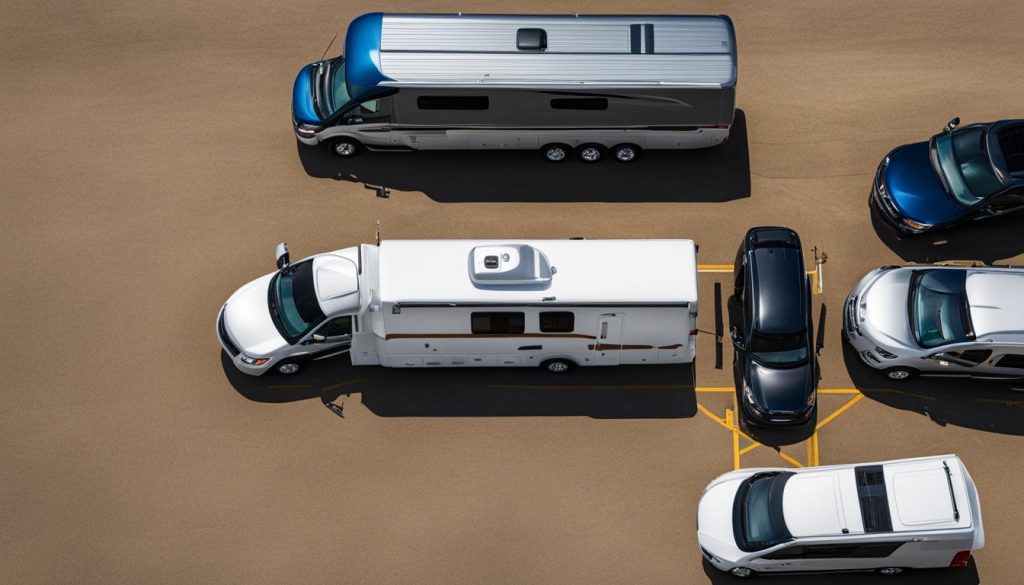
Important Steps To Remember About RV Weighing
When weighing your RV, there are several important steps to keep in mind. Following these steps will help you obtain accurate weight data, make informed decisions about weight distribution, and ensure your RV is safely within its weight limits.
1. Load Your RV as It Would Be Set Up for Travel
Before weighing your RV, ensure that it is loaded with all the essentials you would typically carry during your travels. This includes items such as camping gear, supplies, and any other belongings you typically bring on your trips. By loading your RV as it would be set up for travel, you’ll get an accurate representation of its weight under typical conditions.
2. Have All Passengers and Pets on Board During Weighing
To get an accurate measurement of your RV’s weight, it’s important to have all passengers and pets on board during the weighing process. This includes everyone who would typically be traveling with you, as their weight contributes to the overall weight of the RV. Don’t forget to include your furry friends too!
3. Ensure Your Tow Vehicle or Motorhome is Also Loaded
If you’re towing your RV with a separate vehicle or driving a motorhome, make sure that the tow vehicle or motorhome is also loaded as it would be for travel. This includes any equipment, fuel, and personal belongings that would normally be carried in the tow vehicle or motorhome. By considering the weight of both the RV and the tow vehicle or motorhome, you’ll have a comprehensive understanding of the total weight you’ll be traveling with.
Following these important steps will enable you to obtain accurate weight data for your RV. With this information, you can make informed decisions about weight distribution and take any necessary steps to ensure that your RV is safely within its weight limits.
Which Method of Weighing Is The Best Option?
The best method for weighing your RV depends on your specific needs and preferences. Both utilizing a certified CAT Scale and opting for a four-corner weigh can provide accurate weight measurements to ensure the safety of your RV and its occupants.
CAT Scales are widely accessible and cost-effective, making them a suitable choice for most RV owners. These scales can be found at various truck stops across the country, offering convenience and ease of use. By following the cat scale RV weighing process, you can drive your RV onto the platform scales and get each axle weighed separately. This method provides accurate weight measurements and is favored by many RV enthusiasts.
On the other hand, the four-corner weigh method offers a more detailed analysis of your RV’s weight distribution. This method involves measuring the weight placed on each wheel position, giving you comprehensive information to optimize weight distribution. Although the four-corner weigh method requires an appointment and may be slightly more expensive, it provides valuable insights for those who prioritize precise weight data.
Ultimately, any accurate weight measurement of your RV is better than not weighing it at all. The most important factor is to prioritize your safety and the well-being of your RV by managing its weight effectively. Choose the weighing method that aligns with your needs and diligently follow the respective process to ensure accurate measurements.
Remember, whether you choose a certified CAT Scale or the four-corner weigh method, the key is to be proactive in weighing your RV at regular intervals. This will enable you to make informed decisions about weight distribution, tire inflation, and overall weight management, enhancing your RV’s performance and keeping you safe on the road.
What Do I Do With My RV’s Weights After I Get Them?
Now that you have obtained the weight measurements of your RV, it’s time to put that information to good use. One important aspect is to determine the proper tire inflation based on the weights you obtained. Ensuring that your tires are within the manufacturer’s recommended weight limits is crucial for safe travels. Incorrect tire inflation can result in poor handling, reduced fuel efficiency, and even tire failure.
Another key step is to make any necessary adjustments to optimize weight distribution. Analyze the weight measurements and consider rearranging items in your RV to achieve the best balance. By redistributing the weight properly, you can enhance stability and prevent any excessive strain on certain areas of your RV, such as the axle or suspension.
If you find that your RV is overweight according to the weight measurements, it’s important to take action. Consider downsizing or removing unnecessary items to bring your RV within its weight limits. Overloading your RV can lead to safety hazards and costly damages. Prioritize the items you truly need and leave behind the ones that can be spared.
Lastly, regularly checking your RV’s weight is crucial for maintaining optimal weight management and safety. Re-weigh your RV periodically, especially after adding or removing significant items. By staying vigilant about your RV’s weight, you can ensure safe travels and avoid any unexpected surprises on the road.
FAQ
How do I weigh my RV at a CAT Scale?
To weigh your RV at a CAT Scale, simply take your RV to a CAT Scale at a truck stop, position it on the platform scales with the assistance of a spotter, and get each axle weighed separately.
Why is weight important for recreational vehicle owners?
Weight is important for RV owners because exceeding weight limits can lead to safety hazards, potential damage to the vehicle, and compromised performance. Proper weight management enhances stability and prevents tire blowouts during travels.
How do I find my RV’s weight rating?
RV manufacturers provide weight ratings, including Unloaded Vehicle Weight (UVW), Cargo Carrying Capacity (CCC), Gross Vehicle Weight Rating (GVWR), and Gross Axle Weight Ratings (GAWR). These ratings determine the maximum weight your RV can carry and distribute properly.
What is a certified CAT Scale, and how does it help weigh an RV?
A certified CAT Scale, also known as a truck scale, is a reliable option for RV weighing. By positioning your RV on the platform scales at a CAT Scale location and getting each axle weighed separately, you can obtain accurate weight measurements for your RV.
What is the four-corner weigh method, and why is it recommended?
The four-corner weigh method measures the weight placed on each wheel position, providing detailed information about weight distribution. This method is recommended for those who want precise weight data to optimize weight distribution, enhance stability, and maintain optimal performance.
What are some important steps to remember when weighing an RV?
When weighing your RV, ensure it is loaded as it would be for travel, have all passengers and pets on board, and include the weight of your tow vehicle or motorhome. These steps ensure accurate weight data for making informed decisions about weight distribution and adjustments.
Which method of weighing is the best option for RV owners?
Both using a certified CAT Scale and opting for the four-corner weigh method provide accurate weight measurements. CAT Scales are more accessible and cost-effective, making them a suitable choice for most RV owners. However, the four-corner weigh method is recommended for those who require detailed information about weight distribution.
What should I do with my RV’s weights after I obtain them?
Utilize the weight measurements to determine proper tire inflation, ensure your tires are within the manufacturer’s recommended weight limits, and make any necessary adjustments to optimize weight distribution. Regularly check your RV’s weight to maintain optimal weight management and safety during your travels.

